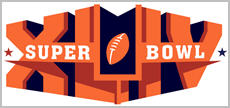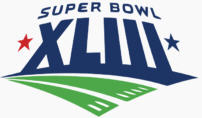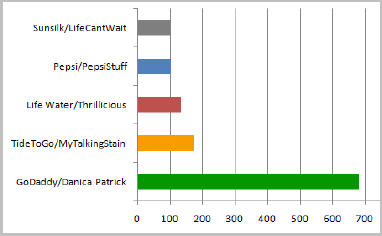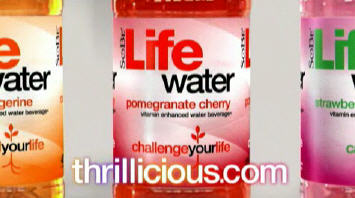-
Roundup of Super Bowl Data: Ad Viewing, Streaming and Social Activity
Super Bowl XLIX will go into the books as one of the most exciting ever, full of unexpected twists and turns, right up until the last few seconds of the game. Importantly, the Super Bowl experience continues to change, with streaming, extended online ad viewing and social sharing. Below I've rounded up the most relevant data I could find about these trends. If I've missed anything, please let me know.
Categories: Advertising
Topics: Extreme Reach, Facebook, Hulu, NBC, Pixability, Super Bowl, Tremor Video, Twitter, wywy, YouTube
-
VideoNuze Podcast #258 - Super Bowl Streaming
I'm pleased to present the 258th edition of the VideoNuze podcast with my weekly partner Colin Dixon of nScreenMedia.
Super Bowl Sunday is upon us. In today's podcast Colin and I first explore the huge role online video has had in driving up the value of Super Bowl ads, which NBC now approximates at $10 million per spot. But despite the ads' tens of millions of incremental online views, we're both still somewhat mystified why the ads don't place more value on viewer engagement, a topic I explored yesterday.
We then turn our attention to NBC's plan to stream 11 hours of programming on Sunday (including the game) without any TV Everywhere style authentication.
As Colin explains, "Super Stream Sunday" is correctly focused on educating viewers about TV Everywhere. But Colin notes one big drawback, which is that the game won't be available on smartphones, since Verizon has the exclusive mobile streaming rights. That means smartphone-wielding millennials could be disappointed.
Listen in to learn more!
Click here for previous podcasts
Click here to add the podcast feed to your RSS reader.
The VideoNuze podcast is also available in iTunes...subscribe today!Categories: Advertising, Mobile Video, Podcasts, Sports, Telcos
Topics: NBC Sports, Podcast, Super Bowl
-
Now Valued At $10 Million Apiece, Super Bowl Ads Still Mostly Lack Engagement
Yesterday, NBCU's EVP of Sales and Sales Marketing Seth Winter announced that all of this Sunday's Super Bowl on-air and online ad units are now sold out. At $4.4-$4.5 million for on-air spots, these are the most expensive Super Bowl ads ever. Winter also reiterated something he said a few weeks ago: he believes a 30-second Super Bowl ad really provides a $10 million value "because of all the incremental exposure that the creative receives on all the different social media platforms like YouTube or publicity."
The comment resonated with me, because way back in 2007, in "On the Road to the $10 Million Super Bowl Ad," I suggested that eventually Super Bowl would in fact reach this level (note that NBC isn't selling the ads for $10 million - yet. It's only saying that's their value).Categories: Advertising, Sports
Topics: NBC, Super Bowl
-
Survey: 37% of Consumers Plan to Watch Super Bowl on Connected Devices
YuMe has released results of a 500-person online survey about Super Bowl XLIX viewing intentions, finding surprisingly strong interest in watching the game via streaming. 37% of those surveyed said they plan to watch via a connected TV device, with 87% watching on TV, thereby implying lots of dual screen watching is in store.
41% of respondents said it was important to watch the game on multiple devices, with 75% agreeing there's less chance of missing out when using multiple devices.Topics: Super Bowl, YuMe
-
Uncovering the Secrets to Why Video Ads Go Viral
The holy grail for marketers these days is having a video ad go viral. Not only does it provide the brand an enormous amount of free exposure, it also gives the team behind the ad major resume points for having "cracked the code" on making an ad a viral hit. However, the odds of an ad actually going viral are extremely long.
That's why a presentation I attended during IAB's NewFronts Insight Lunch last week, by Richard Kosinski, president of Unruly, really caught my attention. Unruly is a platform for social video marketing that helps agencies and advertisers get their videos watched and shared. Richard shared highlights of a new white paper, "The Science of Sharing 2014," which looked at the social performance of 14 different ads from Super Bowl XLVIII.Categories: Advertising
Topics: Super Bowl, Unruly
-
The Super Bowl, the Olympics and the Future of Programmatic Video
Wednesday, March 26, 2014, 9:08 AM ETPosted by:Programmatic video advertising came of age around the recent Super Bowl. Many video publishers, offering an unprecedented volume of pre-roll ads programmatically, sold out all available inventory for 24 hours before the game and 48 hours afterwards at record CPMs.
The Super Bowl of course has special appeal to advertisers because it's perhaps the only TV event where consumers actually make a point of watching and caring about the commercials! But the increasing desire of marketers to supplement buys in big live TV events with online video advertising shows no signs of abating. From the recent Golden Globes and Grammy Awards to the Winter Olympics and Oscars, advertisers are increasingly using the programmatic marketplace to gobble up pre-roll inventory on sites that reach prospective customers.Categories: Advertising, Programmatic
Topics: LiveRail, Olympics, Super Bowl
-
Why the Perfect Storm for Super Bowl Ads Will Continue
Back in February, 2006, I wrote a newsletter titled, "The $10 Million Super Bowl Ad?" In it, I suggested that sometime in the future, a Super Bowl ad could cost $10 million, up from the $2.5 million they were then selling for. My rationale was that subsequent online video viewing opportunities would drive not just exposure, but also new creative opportunities to engage the audience, translating to more advertiser value.
As it has turned out, the value of Super Bowl ads has indeed continued to march higher, with this year's spots going for $4 million. And no question, the subsequent online video views that Super Bowl ads receive reduce the net CPM that advertisers are in effect paying. But what I didn't anticipate were 3 key trends that have made Super Bowl ads even more valuable - and will continue to do so: the accelerating fragmentation of TV audiences, an emerging pre-game release/teaser strategy for the ads and the escalating media coverage Super Bowl ads themselves now receive.Categories: Advertising, Sports
Topics: Super Bowl
-
Streaming the Super Bowl is No Big Deal, For Now
The NFL and NBC garnered a lot of attention yesterday with news that the Super Bowl (along with the Pro Bowl and two Wild Card games) will be streamed online for the first time, and made available to Verizon's mobile subscribers. I'll admit, when I first read the news my reaction was "that's pretty cool!" But when I thought about it for another moment, my feeling changed to "so what's the big deal?" Maybe I'm being a skunk at the picnic, but I'm guessing some of you may have had a similar response. Why?
Categories: Broadcasters, Sports
Topics: NBC, NFL, Super Bowl
-
NBC Testing Super Bowl Ad Rates of $3.5M Per 30-Second Spot
A report this week in AdAge indicated that NBC, which has the broadcast rights to next year's Super Bowl XLVI, is testing advertiser reaction to a rates of up to $3.5 million per certain 30-second ads. This would be a bump from this past year's rates of $2.8-$3.0 million and would easily be the most expensive ad time in history. However, the potential increase was not only predictable, I think it's actually just the start of a significant run up yet to come.
Topics: NBC, Super Bowl, Visible Measures, Volkswagen
-
Super Bowl Advertisers Finally Tapping Into Power of Social Media and Online Video
A great article in today's NY Times shows how numerous Super Bowl advertisers have been building excitement for their ads through social media, and in some cases by already releasing the ads in their entirety. It's the right approach, though a little late in coming. Deep in the pre-VideoNuze archives is "The $10 Million Super Bowl Ad," which I wrote back in 2006, asserting that online video would dramatically enhance the value of these expensive spots. Super Bowl spots have risen in price since, to $2.8-$3.0 million apiece, and in the very long-term I'd maintain they still may get to $10 million as the Super Bowl further separates itself as the last mass broadcast event. But regardless of the price, the key is extracting the most value from them; that's what social media and online video do best.Categories: Advertising, Sports
Topics: Super Bowl
-
From an Online Video Perspective, Super Bowl Ads Are a Mixed Bag
The great Super Bowl game last night was once again not matched by the quality of the ads, at least when viewed for how well they leveraged online video. For several years now, I've been arguing that the $2.5-3 million that advertisers spend on their 30 second Super Bowl spots could yield a far higher ROI if they figured out how to extend their experiences through online video. So once again this year I've reviewed all of the Super Bowl ads - not for how funny, creative or gross they were - but for how well they took advantage of the benefits online video offers.
First, some basic stats: of the 58 ads that ran during the game last night (which I viewed this morning at CBSSports.com), 38 of them were tagged with a URL and 20 were not. On a percentage basis that's about equal to last year, when 37 of the 56 ads carried a URL. Of the 38 ads with a URL, only 4 of them explicitly urged the viewer to see more or watch more at their web sites:
-
Focus On the Family - The controversial Tim Tebow advocacy ad invites viewers to visit the Focus web site to see the full Tebow story. The site has a long interview with Tebow's parents along with lots of other video. Regardless of your politics, the ad works well as a friendly teaser for viewers to learn more about the organization.
-
Boost Mobile - Jim McMahon and the hilarious rapping NFL players take it to a new level by actually ending their rap with the line "Go online to find the rest of our jam," then exposing the URL. Further videos at the site continue the fun.
-
GoDaddy - The web site hosting company was back with its ads featuring Danica Patrick and teasing viewers to "See more now at GoDaddy.com." The scantily-clad GoDaddy girls concept is a little stale now, but for the male-dominated game audience, there's no doubting its appeal.
- HomeAway.com - My personal favorite, this vacation home rental company bought back Chevy Chase and Beverly D'Angelo as The Griswolds for "Hotel Hell," a spoof of the famous "Vacation" movie series. The ad is totally focused on getting viewers to see the film at HomeAway.com. Chase is a classic and the videos are very clever.
Outside of these four, a handful of others are on my honorable mention list. From a user involvement standpoint, CareerBuilder's provocative ad with workers walking around in their underwear (which was the result of its "Hire My TV Ad" contest) was a winner and built on the success Doritos has had with its own $1 million user-generated contest. Monster.com has an interesting engagement opportunity at its site, allowing users to create their own "Fiddle a Friend" music videos with their violin-playing beaver. Speaking of animals, you had to love Bridgestone Tires' "Whale of a Tale" ad featuring 3 guys trying to drive a whale back to the ocean - Bridgestone makes behind the scenes clips here.For more behind the scenes, Dove's new Men Care line features an interview with MVP Drew Brees, who's also shown lathering up in the shower (a blatant pitch to women as well as men). E-Trade was back with its talking babies, but this year with a twist, allowing site visitors to send their own "Baby Mail" emails. The new Honda Accord Crosstour features a well-produced video of the car, though no mention of the video is made in its game ad. And how about the futuristic Vizio ad trumpeting its Internet-connected TVs? It's surely a sign of many more connected device ads to come in future years.
Lastly, a few real misses. First up, what's the deal with Budweiser? It ran 9 ads and not one of them carried a URL. These folks are mistaken in thinking that viewers wouldn't be interested in more about the Clydesdales on the web. Beyond the horses, it would have been cool to learn more about how Bud made the human bridge ad, or did the voice effects in the T-Pain spot. Ditto for Denny's which was promoting its Grand Slam breakfast hard, but didn't do any web tie-ins. The movie ads make me nuts too. They roll the credits so fast at the end of the ad and the text is so small that it's nearly impossible to find a URL to learn more about the movie, even if you wanted to.
The Super Bowl is the biggest event on the sports and advertising calendars, yet as evidenced by this year's performance, most brands and agency creative types still don't fully understand the power of online video. Sure, the post-game galleries drive millions of additional views, but I continue to contend they could be so much more. Oh well, onto Super Bowl XLV.
What do you think? Post a comment now (no sign-in required).
Categories: Advertising, Sports
Topics: Boost Mobile, Focus on the Family, GoDaddy, HomeAway.com, Super Bowl
-
-
Will This Year's Super Bowl Ads Finally Leverage Online Video?
It's Super Bowl time again, which means it's time for me to write my annual post wondering whether this will
 be the year that Super Bowl advertisers really embrace online video and social networking opportunities. Four years ago, I speculated that at some point a Super Bowl ad could go for $10 million apiece, because the online video extensions could drive the ROI so much higher than what a traditional 30 second ad alone delivers. Nonetheless, advertisers and their agencies have been painfully slow to get with the online video program, and I've been ranting about the missed opportunities (see here and here) year after year.
be the year that Super Bowl advertisers really embrace online video and social networking opportunities. Four years ago, I speculated that at some point a Super Bowl ad could go for $10 million apiece, because the online video extensions could drive the ROI so much higher than what a traditional 30 second ad alone delivers. Nonetheless, advertisers and their agencies have been painfully slow to get with the online video program, and I've been ranting about the missed opportunities (see here and here) year after year.As this NY Times piece describes though, this could finally be a breakthrough year. I like the way that Kathy O'Brien, VP for personal care at Unilever put it, "The Super Bowl is an element of a complete, 360-degree campaign." That's smart thinking. On Monday I'll tally up the score to see how this year's Super Bowl advertisers did with their online video and social networking extensions.
What do you think? Post a comment now (no sign-in required).
Categories: Advertising, Sports
Topics: Super Bowl
-
VideoNuze Report Podcast #5 - Feb 6, 2009
Below is the 5th edition of the VideoNuze Report podcast, for Feb. 6, 2009. Once again, Daisy Whitney and I are talking about posts we've made recently. This week Daisy discusses her post about Facebook and Ashton Kutcher linking up to launch "Katalyst HQ." I provide some additional background on the Super Bowl ads which had a broadband video component based on data I shared in this post: "Super Bowl Ads are a Broadband Fumble Again."
Click here for previous podcasts
The VideoNuze Report is now available in iTunes...Just search for "VideoNuze" and subscribe today!
Categories: Podcasts
Topics: Ashton Kutcher, Facebook, Podcast, Super Bowl
-
4 More Thoughts on the Super Bowl Ads
The Super Bowl ads are continuing to generate all kinds of buzz and continued chatter. In the spirit of "everything's been said, but not by everyone," here are a few additional broadband-related thoughts.
Doritos user-generated contest is a big winner - Doritos snagged 2 of the top 5 placements in the USA Today Ad Meter popularity rankings, displacing Anheuser-Busch for the first time. The fact that the Herbert brothers of Indiana could have created an ad more popular than all of those by the pros is impressive enough. More interesting though to me is Doritos is steadily morphing its brand into one which its customers control. This was the 3rd time Doritos handed over its Super Bowl advertising to fans to both submit ads and also vote on them. I've written about other brands' UGV contests, but Doritos is clearly the furthest along in embracing this concept. It's a great differentiator for the brand and will only build further momentum in the future.
Hulu's ad: funny but confusing - did you catch Hulu's first-ever Super Bowl ad starring Alec Baldwin as a creepy alien? The tag line was "Hulu: An evil plot to destroy the world. Enjoy." I thought the ad was hilarious and Baldwin's a classic, but I have to say I found myself wondering if this is really the best positioning for Hulu, the premium online video aggregator?
The ad development process usually starts with identifying key brand attributes (e.g. "convenient," "affordable," "wide variety," "hip," etc.). Did the Hulu marketing team start with attributes like "deceitful" or "creepy" or "offbeat?" Seemingly so. Although the spot was fun, it didn't do anything to articulate Hulu's great value proposition. Further, is Hulu now going to pursue this creepy positioning further? If they do, does that make sense for the brand? But if they don't, wasn't the ad a waste of effort, with little continued momentum? I'm not an ad expert, but I'm not clear on what Hulu was trying to do here, other than get some great yucks.
How about some more "behind-the-scenes" and "making-of" video - Ad executives don't seem to understand what filmmakers discovered with DVDs years ago - that the backstory around the final cut is often even more interesting to fans. Since DVDs offer the capacity to provide director's notes, explanations of special effects, outtakes, actor interviews, etc they often do. This stuff is fascinating. Same with broadband; it offers brands the ability to provide a lot more video than just the ads themselves on their web sites, which some did indeed do.
But many others who could have done so, did not. Two that come right to mind: Coke, whose fascinating ad with insects stealing a sleeping man's bottle had some of the best special effects ever. How about some interviews with the computer animation team that did them? That would be fascinating. The other: E-Trade's talking babies. How'd they do that? Would love to know.
Should ads be rated or filtered? Ok, here's something controversial to think about - should Super Bowl ads be rated or filtered somehow? This is supposed to be family entertainment after all, isn't it? Does the woman getting stripped in the Doritos "Bus" ad or the suggestive GoDaddy girls belong in prime-time? I wonder. Or maybe the online galleries should rate the ads somehow? Maybe the racier ones deserve a parental warning? Just a thought.
Ok, that's it for the '09 Super Bowl, on to other topics...
What do you think? Post a comment now.
Categories: Advertising, Sports
Topics: Super Bowl
-
Super Bowl Ads are a Broadband Fumble, Again
Once again it was an incredibly exciting Super Bowl. And once again, the ads were a broadband fumble. I've been saying for three years now that broadband has introduced a whole new opportunity for Super Bowl advertisers to derive more value and drive engagement, making the ridiculous $3 million per ad that they pay far more worthwhile. Regrettably, the brains behind most of the Super Bowl's ads seem hopelessly oblivious to this notion.
I've watched all 56 ads this morning to see which ones had a broadband or online component. Here's what I found:
- 37 of the ads (66%) were tagged with the advertiser's URL (though some of them went by so fast it would have been nearly impossible to remember or write them down). Akamai has reported traffic spikes for many of these sites. For the online sites like Priceline, Overstock, Monster and CareerBuilders, tagging works very well to reinforce the brand.
- 19 of the ads (34%) were not tagged with the advertiser's URL. Oddly, this includes all of the Budweiser ads. From the people that brought us Bud.tv one would think they'd have a little more appreciation for the role of the web.
- Of the 37 ads with a URL shown, only 6 contained an explicit call to action to visit the web site (GoDaddy "Continues at GoDaddy.com," Disney-Pixar "Up" movie, "To see a special first look go to Disney.com," Universal Heroes, "Visit site for a free 7 day ticket," Monster.com, "Never been a better time to go to Monster.com,", Frosted Flakes, "Help decide where at FrostedFlakes.com," and Vizio, "Visit us at Vizio.com to check out 55 inch million dollar event."). These show solid attempts at engaging the audience beyond the on-air ad itself.
- Upon visiting the web sites of the 37 advertisers who tagged their ads with their URLs, 29 of them contained some video. But of these only 13 offered some video beyond just a replay of the ad. That means that of the total 56 ads, just 23% leveraged broadband video in some meaningful way.
What are a few examples? GoDaddy was surely a hands-down video winner again, by urging viewers to visit their web site, presumably for even more titillating video of the GoDaddy girls and Danica Patrick. Bridgestone Tires offered behind the scenes of how their Potato Head ad was created. Three films, "Year One, " "Up" and "Monsters vs. Aliens" all provided some first look or behind the scenes video. Gatorade introduced the "MissionG" reality series that the brand is sponsoring. NFL.com which showed the winner of its "Super Ad Contest" (Usama Young) also has the full gallery of all the players' ads. In addition, Discovery told me that Toyota has a very cool "Making of" video for its Killer Heat ad for its Tundra playing on HowStuffWorks.com. Unfortunately, there was no promotion of it during the ad itself, or even on Toyota.com.
Special mention of course to Doritos and its $1 million user-generated ad challenge. Amazingly, it looks like the ad did indeed top the USA Today AdMeter, and the creators are getting the $1 million prize.
For all the other advertisers, this year's Super Bowl was much like all of the prior ones. Come up with your most creative idea, work your tail off to execute it, and get your 30 seconds of fame. Sure, with all of the online viewership, the total number of impressions will be far higher than past years. But still, I'm just amazed that more advertisers don't seize on broadband's benefits to build their audience and engagement.
Three years ago I thought for sure this would happen, and as a result I was speculating that Super Bowl ads could eventually fetch $10 million. But with each passing year I'm getting a little more skeptical that big brand advertisers and their agencies actually understand what's happening with broadband video and how it opens up new horizons for them. Maybe 2010 will be different...
What do you think? Post a comment now.
Categories: Advertising, Sports
Topics: Super Bowl
-
2009 Super Bowl Ads to Hit $3 Million, Broadband's Role Must Grow
The Wall Street Journal reported yesterday that NBC will announce next week that the starting price for a 30 second ad during the 2009 Super Bowl will cost $3 million, a 10% increase over 2008. For sure one thing this
 means to me: broadband video's role must grow in order to earn Super Bowl advertisers a return on these outsized rates.
means to me: broadband video's role must grow in order to earn Super Bowl advertisers a return on these outsized rates.As some of you know I've been writing about this topic for the last few years, even preceding the launch of VideoNuze. In Jan '06, in "The $10 Million Super Bowl Ad?" I argued that Super Bowl ad prices were heading nowhere but up given the historic opportunity to fuse the best of brand advertising with the best of online advertising.
I thought the linchpin would be brands recognizing that broadband video elements (e.g. larger campaign narratives, user contests, etc.) should precede and/or follow the game ad, creating a far larger engagement and ROI scenario. With more potential benefits, Super Bowl ad buying would be far less risky and therefore more advertisers would be compelled to buy, thus driving prices up.
While prices have risen, it's been more because audiences have continued fragmenting, making the Super Bowl truly a once-a-year advertising opportunity. NBC's willingness to raise prices by 10% over '08, in the face of a difficult U.S. economy is further testament to the big game's luster.
Back in '06 I forecasted that creative lightbulbs would be going off on Madison Avenue for how to capitalize on broadband's potential to add value. Sadly in the last 2 years this hasn't materialized. In Jan '08, in "My Rant About Super Bowl Ads" I lamented the fact that of the 52 game ads, only 5 (later revised to 6) ads had a broadband component. While the ads themselves were viewed for weeks after in online galleries, the stark reality was that tens of millions of dollars of client ad spending was being dramatically sub-optimized by not incorporating any broadband video elements.
It may be unfair of me to say, but I place the disproportionate share of the blame for this on the agencies behind the Super Bowl ads. They seem oblivious to how their clients' ad strategies must change to reflect broadband and online's importance.
So here's my message to brands considering a Super Bowl '09 ad buy: with 8 full months until game day, if your agency is not presenting you now with at least a half dozen compelling ideas for how to incorporate broadband elements into your Super Bowl ads, switch agencies now. I mean it. They are under-serving you. Find an agency that gets it, not one that is stuck in a time warp. The brands that will really score in the '09 game will have ads that reflect today's broadband realities.
Categories: Advertising, Brand Marketing, Sports
Topics: Super Bowl
-
A Little More Super Bowl Fun
OK, today no rant, just one more little insight to offer from Super Bowl ads.
Yesterday I highlighted the 5 ads (out of the total 52) which had a broadband component. They were:
GoDaddy - promoting Danica Patrick's "Exposure" banned ad and other videos
TideToGo - promoting "MyTalkingStain.com" a fun microsite
SoBe LifeWater - promoting "Thrillicious.com" a microsite where 2 more spots with the dancing lizards can be seen
Sunsilk - promoting "LifeCantWait.com", a microsite with a UGC contest which is not yet active
Pepsi - promoting "PepsiStuff.com", where users can download videos and music
I'm able to track click-throughs to each link I share in these emails. I thought you might be interested to see a graph of these clicks from yesterday. Note they're shown as an index, not actual numbers, with a starting index value of 100 for Sunsilk.

As you can see, VideoNuze email recipients expressed a pretty strong interest in the GoDaddy.com Danica Patrick ad. I'm sure many of you are not surprised since it has a pretty overt potential payoff for visitors.
Though the specifics of that payoff (is Danica actually going to remove her jacket and expose herself?) are very enticing, I think the larger issue to pay attention to is: how can advertisers explicitly use suspense, uncertainty and payoff to drive audiences to do something? Here's the last frame of the Danica spot:

To make this more tangible, consider this: The SoBe LifeWater ad was easily the most impressive use of special effects of all the Super Bowl ads. No doubt the SoBe LifeWater folks spent heavily making the ad, and then paying supermodel Naomi Campbell to dance with the pack of lizards to Michael Jackson's "Thriller." It certainly qualifies as the kind of thing that people would be interested in seeing more of, had SoBe LifeWater teased fans the right way at the end of the ad.
But they didn't. Instead, they simply flashed the URL "Thrillicios.com" at the end of the spot. Nothing was said about what to expect there, why you should go there, what surprises were in store, etc. (In fact there are 2 very funny and clever "episodes". And by the way, does this imply a new Life Water iguana series? Who knows?). Here's the last frame of the SoBe spot:

The point is this: I think SoBe LifeWater missed a huge opportunity to keep viewers engaged, which would have both improved the ROI on their Super Bowl ad spend, and also deepened viewers' engagement with the brand. While the Campbell spot was hugely entertaining, it did little to power ongoing engagement. Contrast this with GoDaddy, which no doubt had people pouring into its web site since the spot ran, with ongoing chatter and brand-building taking place.
As I said yesterday, advertisers need to understand how to use broadband video to evolve Super Bowl ads from having big-time entertainment value to having big-time engagement value. Some like GoDaddy get this, while many others, like SoBe LifeWater, are still on the learning curve.
What do you think? Post a comment and let us know!Addendum - I missed this piece in AdAge "GoDaddy Super Bowl Spot Sets Web-Traffic Record." The "Exposure" on-air ad drove 2 million visits to the site, during the game alone, a record for GoDaddy since it began advertising on the Super Bowl. And no doubt a multiple of that since the game ended. More evidence that GoDaddy nailed it big-time.Categories: Brand Marketing, Sports
Topics: GoDaddy, Life Water, Pepsi, Sunsilk, Super Bowl, TideToGo
-
My Rant About Super Bowl Ads
I love the Super Bowl ads as much as anyone. I never stop being amazed by the creativity and humor on display during each year's big game. This year was no exception: screeching squirrels, a strutting heart,
 shrunken heads, talking babies, the list goes on. For what Super Bowls ads are and always have been, they're terrific. My problem is that I believe broadband video allows Super Bowl ads to be much more than what they are and always have been. But the agency world does not seem to be getting this message.
shrunken heads, talking babies, the list goes on. For what Super Bowls ads are and always have been, they're terrific. My problem is that I believe broadband video allows Super Bowl ads to be much more than what they are and always have been. But the agency world does not seem to be getting this message.Two years ago I wrote "The Ten Million Dollar Super Bowl Ad?", where I outlined a scenario under which a 30 second spot could someday go for ten million bucks. How? By combining the best of brand advertising (the big emotional play) with the best of online advertising (the big measurable, performance-oriented play).
I wrote in that post: "What I envision is that the 30-second spot during the game will become the viewer's introduction or re-introduction to the brand or product. Numerous online, broadband-centric tactics will follow, with video being the center of the action. In football terms, the 30-second spot will morph from throwing a long pass (which is accompanied by high drama, but low probability of an actual score) to executing a more consistent ground game (accompanied by lower drama, but a much higher probability of an actual score). With this added measurability and a direct feedback loop, marketers will have much less anxiety about whether to ante up for the big game (and therefore the price will spiral upward).
I thought agencies and marketers would see this light and rush toward it. Boy was I over-optimistic. After watching all 52 Super Bowl ads this morning (thanks AOL), I am completely dismayed to report that, by my count, only 5 ads had any broadband video component:
GoDaddy - promoting Danica Patrick's "Exposure" banned ad and other videos
TideToGo - promoting "MyTalkingStain.com" a fun microsite
Life Water - promoting "Thrillicious.com" a microsite with a 2nd spot with the dancing iguanas
Sunsilk - promoting "LifeCantWait.com", a microsite with a UGC contest which is not yet active
Pepsi - promoting "PepsiStuff.com", with Amazon (ok, more focused on music than video)
All of the other 47 ads, representing tens of millions of dollars of clients' money, followed the same game plan from Super Bowls' past: go for either the clever, the funny or the gross, in an attempt to create buzz and fond memories for fans.
For me, this hidebound behavior showcases agencies at their most disappointing: unable to break out of the box, recognize new consumer engagement opportunities for their clients or embrace new technologies. Their inability or unwillingness to be more progressive is at the heart of why the whole advertising industry is in such chaos, with an increasing share of total spending shifting to online each year.
Nonetheless, I remain a long-term optimist. Maybe I'm crazy, but I'm still betting that someday, somehow, more agencies and brands will wake up and realize what the 5 brands above did this year: the combination of on-air and broadband is how to score a touchdown.
What do you think? Post a comment and let us all know!
Categories: Advertising, Sports
Topics: GoDaddy, Life Water, Pepsi, Sunsilk, Super Bowl, TideToGo
-
Ads On Top of Ads? It’s Super Bowl Mania
OK, even as the enthusiast that I am about the value of Super Bowl ads increasing, this seems over the top to me. WSJ is reporting that a number of sites are selling pre-rolls on their Super Bowl ad galleries. Call me skeptical, but I just don't see how consumers are going to stomach this.
Categories: Brand Marketing, Sports
Topics: Super Bowl
-
On the Road to the $10 Million Super Bowl Ad
In February of 2006, following Super Bowl XL, I wrote a newsletter entitled, "The $10 Million Super Bowl Ad?". I suggested that despite all the anxieties around the future of the 30-second spot, the future of Super Bowl ads was very bright. This was the case because of all the broadband and online opportunities that can lead into and follow up the 30 second ad that shows during the game.
My proposition was that marketers would be less concerned about "throwing the long ball", i.e. spending $2.5 million per spot ($2.6 million for Super Bowl XLI, btw) if they were able to monetize that investment beyond just the on-air showing. And broadband is a great way of doing exactly that.
Today Stuart Elliott at the NY Times had a great piece, "Multiplying the Payoffs From A Super Bowl Spot", exactly on this point, and how it's playing out for Super Bowl XLI. It showcases the advertisers who are leveraging broadband this year, including Anheuser-Busch, GM and Garmin. I continue to forecast that broadband is only going to drive the price of 30 second Super Bowl spots (and in fact likely add new value to all :30s) higher as marketers come to understand how they can leverage their investments and tangibly drive revenues from them.
Categories: Brand Marketing, Sports
Topics: Super Bowl
Posts for 'Super Bowl'
Previous |




